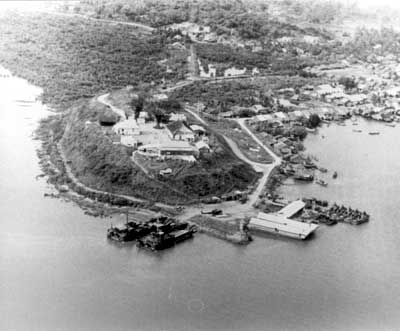
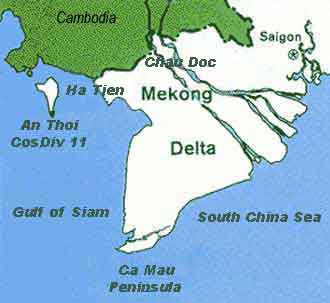
| Ha Tien |
| Entrance to the Giang Thanh River | Gulf of Siam East of An Thoi |
 |
 |
Ha Tien was perhaps the first forward location to be utilized as a base for supporting Swift Boat operations aimed at interdiction in the South Vietnam rivers close to the Cambodian border. It was, however, originally set up as a very temporary stopping point for crew rest by Swifts on Operation Market Time patrols in the Gulf of Siam away from the primary base at An Thoi |
On October 14 1968, shortly after Admiral Zumwalt conceived of SEALORDS, Swift Boat OinC Mike Bernique was informed by local Vietnamese at Ha Tien that the VC had set up a tax collection site a few miles up the Giang Thanh River from Ha Tien. |
Even though it was strictly forbidden by the Rules of Engagement for Swift Boats to operate that far up the rivers, Mike proceeded
to follow up on this lead and investigated. He discovered the collection site and a fire fight ensued. This resulted in five of
the enemy being killed and the recovery of supplies, weapons, ammunition and documents left behind by the fleeing communists.
Mike was called to Saigon to explain his conduct and to respond to a heated diplomatic protest by Cambodian Prince Sihanouk that he
had fired across the border into that supposed neutral country. Facing possible disiplinary actions, he answered Admiral Zumwalt's
questions with an emphatic "Tell Sihanouk he's a lying SOB."
| 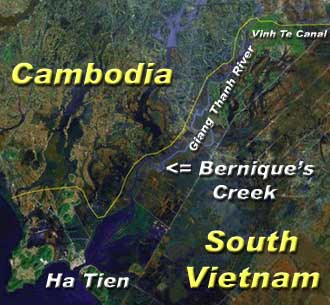
|
The Admiral declared that Bernique was exactly the kind of aggressive skipper he was looking for and awarded him a Silver Star instead of a general court marshal.
Eventually, patrols were augmented throughout the length of the Giang Thanh River and extended from its northeastern head along the Vinh Te Canal to the east all the way to the western bank of the Bassac river. Interdiction operations included not only Swift Boats, but also PBRs (Patrol Boat River) and units of the Navy's Mobile Riverine Force. |
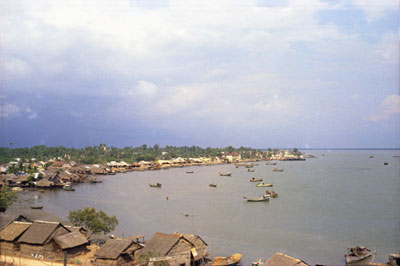 |
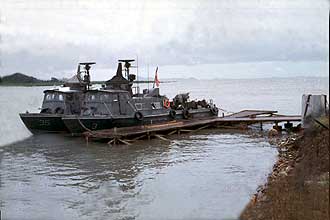 |
|
|
Ha Tien Town and Harbor as viewed from the Swift Base Images Copyright � 2003 by William L. Rogers |
Original Swift Pier at the base of the hill Image Courtesy of Gary Carpenter |
Ha Tien was also enhanced to become the western anchor for these operations, although never a really major base. As seen in 1970, just enough boats were stationed at this small location to support four continous patrols of twelve hours in length. The small pier at Ha Tien was on the north side of the river / bay entrance and was only large enough to support the boats nested outboard of one another. The majority of the boats were pointed up river with the gulf to the right or west. Not only was this the direction of daily patrols, but they were also on standby to act as emergency relief of the town of Ha Tien and the USN Construction Battalion (SeaBee) base there in case of attack. |
 |
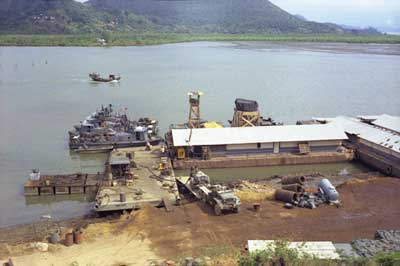 |
|
|
A scratch baseball game in front of the Swift Pier Image Courtesy of Gary Carpenter |
The expanded and enhanced pier for Swifts & PBRs later Image Copyright � 2003 by William L. Rogers |
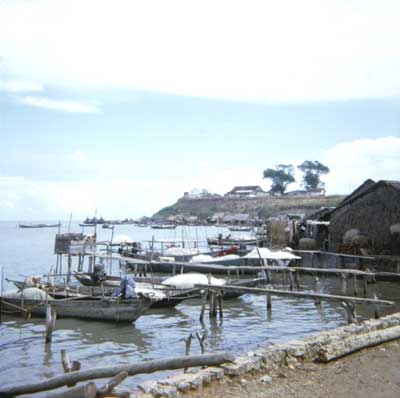 |
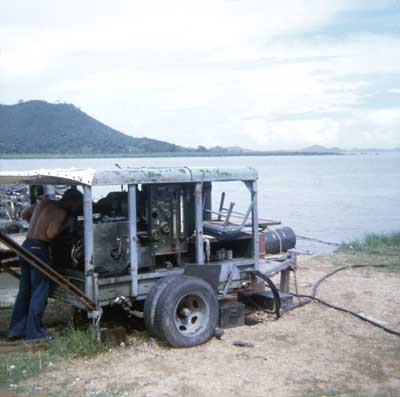 |
|
Images courtesy of Dave Stevenson |
Administrative buildings and berthing quarters for the Vietnamese military were at the top of the hill overlooking the pier and nested boats. Swift Boat sailors made do for themselves in terms of lodging (aboard their craft) and sustenance. The only potable water available for drinking and bathing came from an old evaporator that was resuscitated and kept in good working order by the enginemen from the crews of the Swifts assigned to the base. |
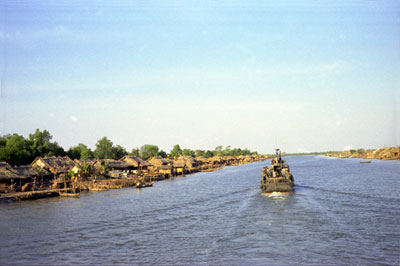
|
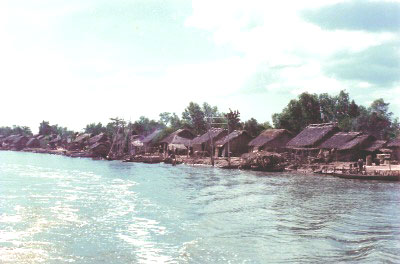
|
Here a Swift Boat is seen departing Ha Tien in the late afternoon hours up the Giang Thanh for patrol. Cambodia will be just north of the left bank as she departs the lake area, with South Vietnam on both sides of the river. Further east, the river narrowed considerably, where there were numerous small villages interspersed by stretches of sparcely inhabited country side on both banks. A frequent task was to debark Army and other units to sweep the Vietnamese side of the river bank for signs of infiltration from Cambodia. |
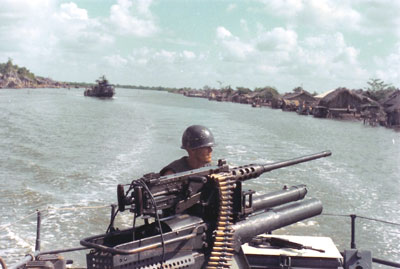 |
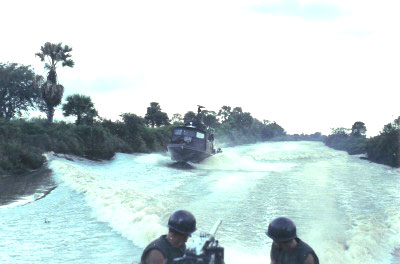 |
|
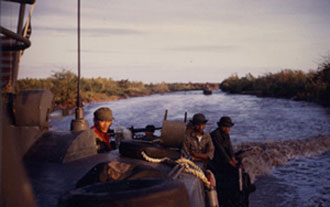 |
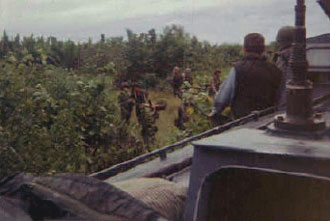 |
| Images Courtesy of Bob Kreyer, Ken Turgeon, Lou Ellingson and Gary Carpenter |
The night time portion of the patrols were used to set up ambushes for attempts by the North Vietnamese troops to cross the Giang Thanh river under the cover of darkness. PCF 38 has beached its bow onto the Cambodian side of the river (but still in South Vietnam) in preparation for its night time vigil. |
 |
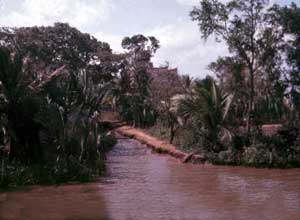 |
|
| Image Courtesy of Bob Yount | Image Courtesy of Gary Carpenter |
On 6 March 1970, while patroling the Giang Thanh in tandem, PCF 9 and PCF 96 were taken under attack by enemy units firing B-40 rockets from concealed positons on the northern side of the river. PCF 9 was hit in the bow, but the Swift was able exit the ambush zone while returning fire, killing several of the attackers and causing the rest to retreat. PCF 96 was not so lucky, receiving three direct hits. Two had entered close together on the starboard bow, and the third blew a hole in the starboard side near the engine room. The blast from this latter hit blew off the life raft from the cabin over head, and also knocked the crewman stationed in the gun tub down into the pilot house. |
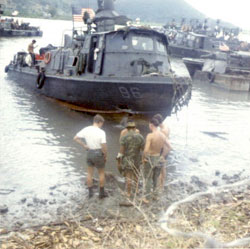
|
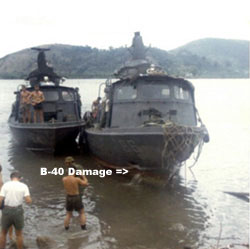
| Fragments from all three rockets also caused sharpnel wounds to the entire crew, and created holes in the hull close to the water line that threatened the integrity of the boat. With these ruptures throughout the hull of the boat, including the major ones from the B-40's, the Swift was in danger of sinking in close proximity to the enemy. But the crew had the presence of mind to remain at top speed, thus keeping the breeches in the hull above water, and proceeded immediately without stopping all the way back to Ha Tien where they were able to beach the boat next to the pier. |
As the two Swift Boats departed the area of the ambush, a pair of PBRs (Patrol Boats River) arrived on the scene and investigted the position used by the NVA soldiers during the attack. They discovered several enemy KIA's and a number of weapons left behind as the attackers retreated. Among the arms recovered was the sole B-40 rocket that had not been fired at the two Swifts. The two PBRs returned to Ha Tien shortly after PCF 96 had beached, displaying the weapons recovered to the relieved crews. The rocket was of great interest to all of the sailors stationed at the base as indicated by the crowd scrutinizing it. Ltjg Bill Kean, OinC of PCF 9 (wearing the watch), is looking for indications of the country of origin of the B-40 round. Not surprisingly, it was made in China. |
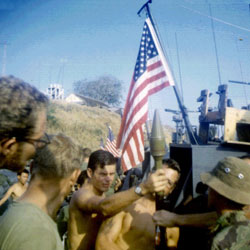 |
This web site is Copyright � 2002 by Robert B. Shirley. All rights reserved. Click on image to return to the homepage
|